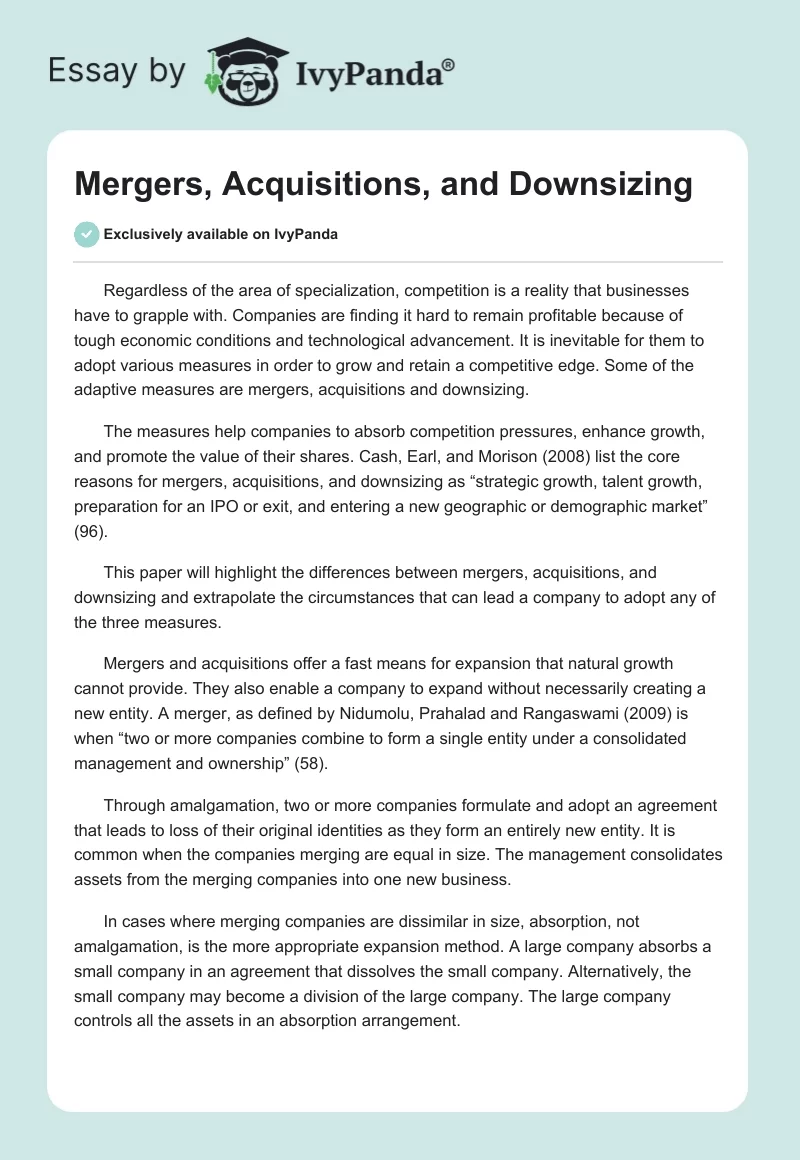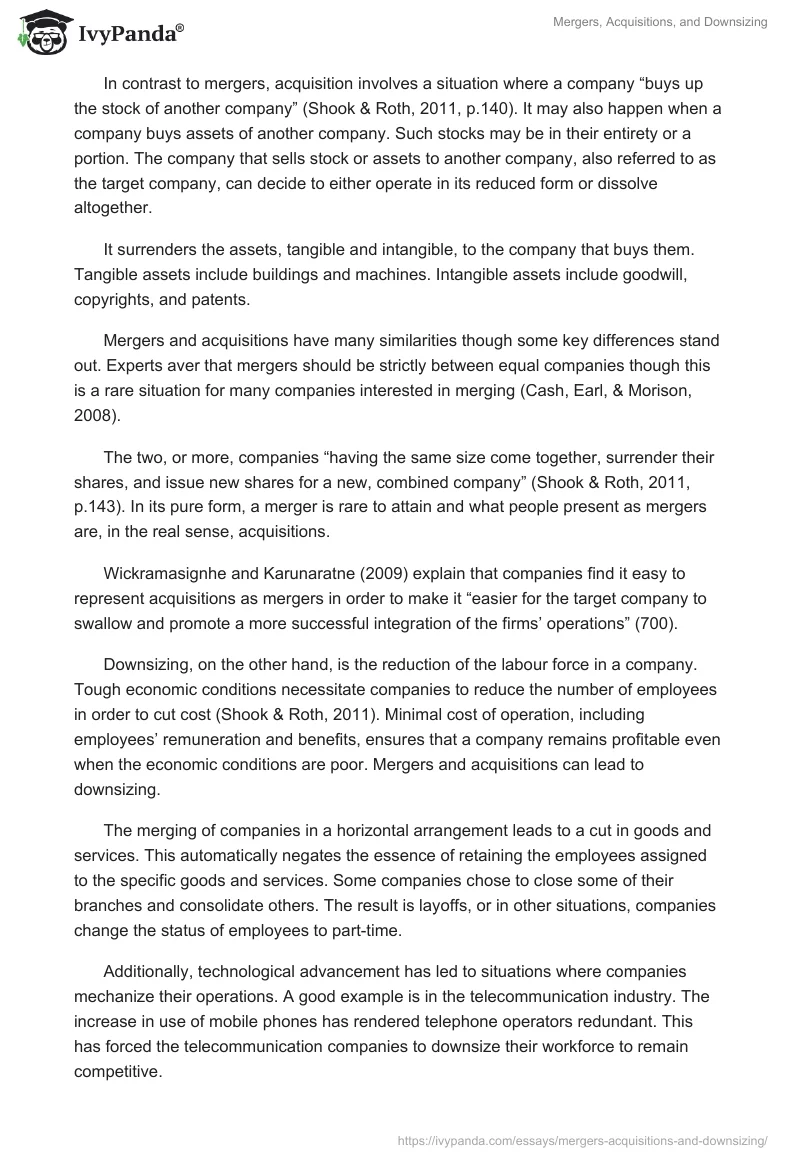Regardless of the area of specialization, competition is a reality that businesses have to grapple with. Companies are finding it hard to remain profitable because of tough economic conditions and technological advancement. It is inevitable for them to adopt various measures in order to grow and retain a competitive edge. Some of the adaptive measures are mergers, acquisitions and downsizing.
The measures help companies to absorb competition pressures, enhance growth, and promote the value of their shares. Cash, Earl, and Morison (2008) list the core reasons for mergers, acquisitions, and downsizing as “strategic growth, talent growth, preparation for an IPO or exit, and entering a new geographic or demographic market” (96).
This paper will highlight the differences between mergers, acquisitions, and downsizing and extrapolate the circumstances that can lead a company to adopt any of the three measures.
Mergers and acquisitions offer a fast means for expansion that natural growth cannot provide. They also enable a company to expand without necessarily creating a new entity. A merger, as defined by Nidumolu, Prahalad and Rangaswami (2009) is when “two or more companies combine to form a single entity under a consolidated management and ownership” (58).
Through amalgamation, two or more companies formulate and adopt an agreement that leads to loss of their original identities as they form an entirely new entity. It is common when the companies merging are equal in size. The management consolidates assets from the merging companies into one new business.
In cases where merging companies are dissimilar in size, absorption, not amalgamation, is the more appropriate expansion method. A large company absorbs a small company in an agreement that dissolves the small company. Alternatively, the small company may become a division of the large company. The large company controls all the assets in an absorption arrangement.
In contrast to mergers, acquisition involves a situation where a company “buys up the stock of another company” (Shook & Roth, 2011, p.140). It may also happen when a company buys assets of another company. Such stocks may be in their entirety or a portion. The company that sells stock or assets to another company, also referred to as the target company, can decide to either operate in its reduced form or dissolve altogether.
It surrenders the assets, tangible and intangible, to the company that buys them. Tangible assets include buildings and machines. Intangible assets include goodwill, copyrights, and patents.
Mergers and acquisitions have many similarities though some key differences stand out. Experts aver that mergers should be strictly between equal companies though this is a rare situation for many companies interested in merging (Cash, Earl, & Morison, 2008).
The two, or more, companies “having the same size come together, surrender their shares, and issue new shares for a new, combined company” (Shook & Roth, 2011, p.143). In its pure form, a merger is rare to attain and what people present as mergers are, in the real sense, acquisitions.
Wickramasignhe and Karunaratne (2009) explain that companies find it easy to represent acquisitions as mergers in order to make it “easier for the target company to swallow and promote a more successful integration of the firms’ operations” (700).
Downsizing, on the other hand, is the reduction of the labour force in a company. Tough economic conditions necessitate companies to reduce the number of employees in order to cut cost (Shook & Roth, 2011). Minimal cost of operation, including employees’ remuneration and benefits, ensures that a company remains profitable even when the economic conditions are poor. Mergers and acquisitions can lead to downsizing.
The merging of companies in a horizontal arrangement leads to a cut in goods and services. This automatically negates the essence of retaining the employees assigned to the specific goods and services. Some companies chose to close some of their branches and consolidate others. The result is layoffs, or in other situations, companies change the status of employees to part-time.
Additionally, technological advancement has led to situations where companies mechanize their operations. A good example is in the telecommunication industry. The increase in use of mobile phones has rendered telephone operators redundant. This has forced the telecommunication companies to downsize their workforce to remain competitive.
A company can opt for merging, acquisition, or downsizing depending on several factors. A merger is suitable when a company wants a fast expansion that a natural growth cannot provide. If the target company is similar in size, a merger would facilitate faster growth than an acquisition (Cash, Earl, & Morison, 2008). This is because it will rebrand and make use of the expanded capital base to compete in the market.
An acquisition is suitable when the two companies are not equal in size. A company can select downsizing if the workforce is no longer sustainable. Additionally, the use of technology may make it possible for few people to perform the job performed by many people.
Poor economic conditions, rapid technological advancement, and increased competition are forcing companies to adopt several measures in order to remain competitive. Mergers and acquisitions enable the companies to forge a partnership that will wither competition pressure. Downsizing enables companies to survive harsh economic times.
References
Cash, Jr., J., Earl, M., & Morison, R. (2008). Teaming Up to Crack Innovation & Enterprise Integration. Harvard Business Review, 86(11), 90 – 100.
Nidumolu, R. Prahalad, C., Rangaswami, M. (2009). Why Sustainability is Now the Key Driver of Innovation, Harvard Business Review, 87(9), pp. 56-64.
Shook, L. & Roth, G. (2011). Downsizings, mergers and acquisitions: Perspectives of human resource development practitioners. Journal of European Industrial Training, 35(2), 135-153.
Wickramasignhe, V. & Karunaratne, C. (2009). People management in mergers and acquisitions in Sri Lanka: employee perception. Journal of Human Resource Management, 20(3), 694-715.


